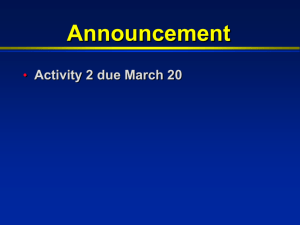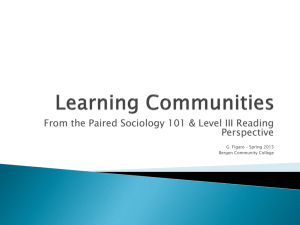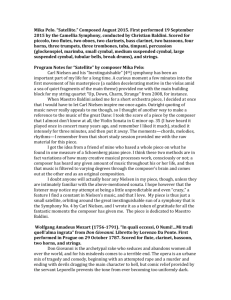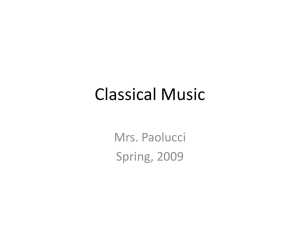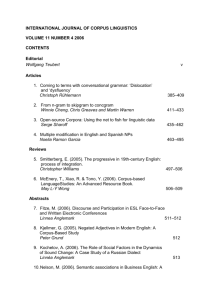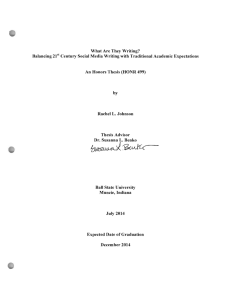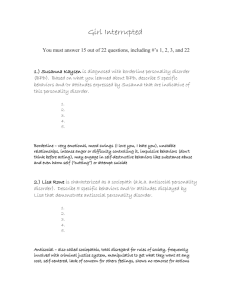MU 710: Understanding Opera - Spring 2013 -... • Choose an aria or short scene from an opera... MU 710
advertisement
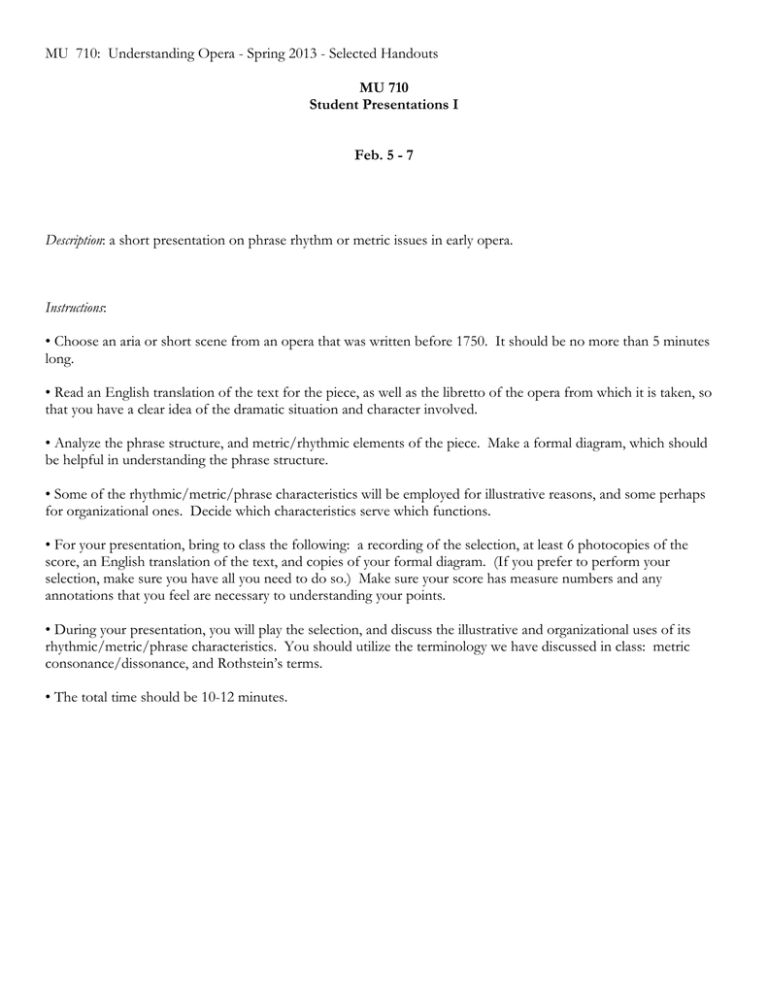
MU 710: Understanding Opera - Spring 2013 - Selected Handouts MU 710 Student Presentations I Feb. 5 - 7 Description: a short presentation on phrase rhythm or metric issues in early opera. Instructions: • Choose an aria or short scene from an opera that was written before 1750. It should be no more than 5 minutes long. • Read an English translation of the text for the piece, as well as the libretto of the opera from which it is taken, so that you have a clear idea of the dramatic situation and character involved. • Analyze the phrase structure, and metric/rhythmic elements of the piece. Make a formal diagram, which should be helpful in understanding the phrase structure. • Some of the rhythmic/metric/phrase characteristics will be employed for illustrative reasons, and some perhaps for organizational ones. Decide which characteristics serve which functions. • For your presentation, bring to class the following: a recording of the selection, at least 6 photocopies of the score, an English translation of the text, and copies of your formal diagram. (If you prefer to perform your selection, make sure you have all you need to do so.) Make sure your score has measure numbers and any annotations that you feel are necessary to understanding your points. • During your presentation, you will play the selection, and discuss the illustrative and organizational uses of its rhythmic/metric/phrase characteristics. You should utilize the terminology we have discussed in class: metric consonance/dissonance, and Rothstein’s terms. • The total time should be 10-12 minutes. Illustrative (I) and Organizational (O) Functions in Opera I-function - any illustrative task performed by an element of the opera (music, drama, text). Example: the presentation of verbal or textual content. O-function - any organizational task performed by an element of the opera (music, drama, text). Example: defining of a structural unit. operatic music’s illustrative (IM) functions: 1.presentation of atmosphere or mood 2. presentation of local or historical color 3. presentation of emotional content and character 4.presentation of physical stage action 5.presentation of verbal and textual content (including stage directions) 6.presentation and/or identification of characters, objects, events or thematic ideas. operatic music’s organizational (OM) functions: 1. framing 2. defining structural units of the opera by musical means 3. continuity (avoiding or obscuring musical units) 4. creating musical syntax 5. creating musical unity M-tool - any musical tool, which can be used to carry out either I-functions or O-functions. Examples: articulation, cadences (or lack thereof), consonance vs. dissonance, counterpoint, dynamics, form, genre, harmony, harmonic syntax, hypermeter, instrumentation, melodic direction, meter, mode, motion to remote/related keys, motivic materials, register, rhythm, scales (diatonic, chromatic, other collections), style, tempo, texture. IM-tool - any musical tool used to carry out illustrative tasks. Example: in “Voi che sapete” from Le Nozze di Figaro, Mozart uses various musical tools to illustrate the dramatic situation (i.e., Cherubino is singing a song). One of these musical tools is instrumentation: pizzicato strings imitate the sound of the guitar that Susanna is supposed to be plucking as “accompaniment” onstage. Therefore, instrumentation is an illustrative musical (IM) tool. OM-tool—any musical tool used to carry out organizational tasks. Example: in “Voi che sapete” an ABA’ form is utilized to organize the operatic number. ID-tools- any dramatic tool used to carry out illustrative tasks. Example: stage properties. Susanna’s onstage guitar indicates that she is accompanying Cherubino’s song. OD-tool—any dramatic tool used to carry out organizational tasks. Example: recurrence (a dramatic repetition that satisfies expectancy). Cherubino has given Susanna a copy of his song earlier in the opera, so the audience knows of its existence. When that song is finally performed, it constitutes a recurrence, satisfying expectancy. Querelle des Bouffons • In 1752, an Italian opera company, led by impresario Eustachio Bambini, was invited to perform at the Paris Opéra. They performed Pergolesi’s La Serva Padrona on the same evening that the regular company performed Lully’s Acis et Galatée. It sparked a controversy in which over 60 letters and pamphlets were written. Some of them were: • anonymous, possibly Diderot: 1753, in pamplet the author compares analogous scenes from a French and Italian opera: Lully’s Armide and Terradella’s Nitocris. Point of view: Armide’s monologue cannot compare with the Italian, having a melody without fire, soul, force or inspiration. • Jean-Jacques Rousseau: 1753, philosopher who also wrote music articles for the Encyclopédie in 1748, and composed the successful French comic opera Le Devin du village. Point of view: melody is the most crucial part of music, there should be one clear melody not counterpoint; in comparing French and Italian music, recitative should be a musical imitation of speech; since Lully’s recitative is in French, it is lacking in melodic and rhythmic interest; Lully’s recitative does not reflect the text, and has neither melody, naturalness or expression. Conclusion: the French do not have music. • Jean-Phillipe Rameau: 1754, composer and music theorist (he invented the concepts of tonic, dominant and subdominant) Point of view: harmony is the sole basis for music, since melody has its source in harmony; associates joy with dominant, sharp keys, major mode, rising melody because they are produced as overtones, while associates sadness with the subdominant, flat keys, minor mode, descending melody. In the Lully recitative, the contrasts of major and minor, and chord changes correspond perfectly with the text. The recitative is a perfect example of modulation since there are cadences in all keys. He also discusses “implied dissonance” in modulations, where a chord’s identity is reinterpreted in the next progression. • Lully, Armide Act II, scene 5: “Enfin, il est en ma puissance” [Armide stands over Renaud, whom her demons have lulled to sleep, with a dagger in her hand, but is overcome by love for him and cannot kill him.] Enfin, il est en ma puissance, Ce fatal ennemi, ce At last, he is in my power, This deadly enemy, this superbe vainqueur. arrogant conqueror. Le charme du sommeil le livre à ma vengeance; The charm of sleep delivers him to my revenge. I will Je vais percer son invincible coeur. pierce his invincible heart. Par lui, tous mes captifs sont sortis d’esclavage, Through him, all my captives have escaped from Qu’il éprouve toute ma rage... slavery, Let him feel all my rage. Quel trouble me saisit? qui me fait hésitet? What disturbance seizes me? what makes me hesitate? Qu’est-ce qu’en sa faveur la pitié me veut dire? What, in his favor, can pity say to me? Frappons...Ciel! qui peut m’arrêter? Achevons..je Let me strike him...Heavens! what could be stopping frémis! Vengeons-nous ...je soupire! me? Finish it!...I tremble! Let us take revenge...I sigh! Venez, secondez mes désirs, Démons, Come, do as I wish, Demons, transform yourselves transformez-vous en d’aimables zéphirs. into pleasant breezes. Je cède à ce vainqueur, la pitié me surmonte; I surrender to this conqueror, pity overcomes me; Cachez ma faiblesse et ma honte Dans les plus Hide my weakness and my disgrace in the most reculés déserts; Volez, coduisez-nous au bout de faraway deserts; Fly, lead us to the ends of the world. l’univers. Lully, Armide, “Enfin, il est en ma puissance,” first phrase Lully, Armide, “Enfin, il est en ma puissance,” mm. 18-22 1. as written 2. Rameau’s analysis Dramatic Action in Le Nozze di Figaro Action Act I 1. Figaro, on knees, measures new bedroom while Susanna tries on bridal hat. Susanna explains that the Count desires her and that the room would give him easy access. 2. Figaro, jealous, challenges the Count, saying that if the Count wants to dance, Figaro will call the tune. 3. Marcellina and Bartolo enter, plan to disrupt wedding using a contract Figaro signed promising to marry Marcellina in lieu of debt repayment; Bartolo wants revenge for Figaro’s previous help in preventing him from marrying the Countess, then exits. 4. Susanna enters, and is insulted by Marcellina. As they both try to exit the door, they curtsey politely but exchange veiled insults in the process. Marcellina exits. 5. Cherubino enters, breathlessly telling how the Count discovered him in Barbarina’s room; all he can think of is love and steals the Countess’ ribbon. As he is about to leave, the Count enters and he hides behind a chair. 6. The Count pursues Susanna amorously until Basilio is heard coming; the Count moves to hide behind the chair, forcing Cherubino to hide in the chair, which Susanna covers with a dress. 7. Basilio enters, asking for the Count, and makes insinuations about Cherubino with the Countess and Susanna. The Count, now jealous, leaps out of his hiding place, and orders Cherubino evicted from the castle. Susanna faints and they carry her towards the chair; she recovers just in time and Basilio apologies forwhat he said about Cherubino. But the Count insists that the page must go, because he has been caught before with Barbarina; the Count then demonstrates how he had lifted Barbarina’s tablecloth—while lifting the dress on the chair—to discover Cherubino, who is present on the chair as well! The Count realizes that Cherubino has heard all the intrigue. 8. A group of peasants, led by Figaro, enter to praise the Count’s renunciation of the droit de seigneur. Figaro wants the wedding to be held there and then. The Count delays, saying that preparations must be made. Cherubino will be sent off to war, and Figaro describes how life will now be different for him. Act II 1. The Countess, begging for relief from grief, prays for Amor to help her, either to give her back Substitutions 1. Figaro, here seen on his knees in a typical servant’s pose, will trade places with the Count, who will be on his knees at the end of the opera. 2. Figaro usurps role of master, using music appropriate to the Count, a minuet. 3. Marcellina wants to substitute for Susanna as Figaro’s bride 4. Trying to substitute for each other as Figaro’s wife—and at the door—Susanna and Marcellina take turns with the musical material as well. 5. and 6. The Count, having earlier substituted for Cherubino in Barbarina’s room, now takes the page’s place behind the chair. 7. When Cherubino is discovered in the chair, he is actually substituting for himself at another location and time in the Count’s story. 8. The Count is being applauded for abolishing the droit de seigneur, when in actuality he is trying to reinstate it. Figaro and the peasants are, in effect, praising the man the Count should be, not who the Count really is. Cherubino is made to take on the persona of a soldier. her husband or to let her die. 2. Susanna enters and recounts the events of that morning. Figaro enters with a plan: he gave an anonymous letter to Basilio saying the Countess will meet a lover that night; then the Count will get so jealous that he will forget about Susanna until it is too late. Susanna is to promise to meet the Count in the garden, while Cherubino will go dressed as her instead, when they will be surprised by the Countess and shamed. 3. Cherubino enters and sings the song he wrote for the Countess. Locking the door, Cherubino begins to undress. 4. The Count, jealous, is heard outside asking why the door is locked. Cherubino hides in the closet. 5. The Countess says the door was locked because Susanna was trying on dresses, and she is now in the closet. 6. Susanna enters through another door, hides in the alcove and hears the argument. The Count decides to go get tools, to break down the door; he leaves with the Countess and locks the door. 7. Susanna opens the closet, lets Cherubino out, and he jumps out the window to escape. She enters the closet. 8. The Count and Countess return with the tools, and the Countess confesses that Cherubino was in the closet, infuriating the Count. 9. When the door opens, it is Susanna not the page, leaving everyone dumbfounded. The Count begs forgiveness of the Countess, which is given. 10. Figaro enters, is accused by the Count of lying about the letter, but he just wants the wedding to begin. 11. The gardner Antonio rushes in with flowerpots broken by someone jumping from the window. The Count is suspicious again, but Figaro claims that he jumped. 12. Marcellina, Bartolo, and Basilio enter with the marriage contract; imbroglio. Act III 1. The Count ponders the situation. 2. The Countess and Susanna enter unseen by the Count and plot for Susanna to arrange a rendezvous with the Count in the garden that evening. The Countess will go in her place. The Count accepts joyfully. 3. Figaro enters and Susanna says their case is already won. 4. The Count, overhearing them, realizes a trap is afoot. He will not be outwitted by a servant. 5. Don Curzio, Marcellina, Figaro and Bartolo enter after the case has been tried: Figaro must pay 2. The plan is for Cherubino to substitute for Susanna. 3. Cherubino (a woman playing a man) is now being dressed as a woman: a double substitution. 4.-9. Who is in the closet? Cherubino and Susanna substitute for each other. 10.-11. Figaro substitutes for Cherubino as the one who jumped from the window. 12. Again, Marcellina wants to substitute for Susanna as Figaro’s bride. 2. The Countess will substitute for Susanna. 5. Figaro is now really Raffaello, Marcellina is no longer the bride but the mother of the groom, with Bartolo as his father and not his enemy. All have traded identities. Marcellina or marry her. Figaro refuses to marry her without the consent of his parents, whom he does not know: he was a foundling and has a distinguishing mark on his arm. Marcellina cries out that he is really Raffaello, the son of Bartolo and herself! Since Figaro cannot marry his own mother, the case is dropped. Susanna enters with money to pay Marcellina, sees Figaro embracing the older woman and is furious: all is explained to her. 6. Marcellina and Bartolo decide to marry. All leave rejoicing. 7. Barbarina takes Cherubino out of harm’s way and dresses him as a girl to join her friends as they present flowers to the Countess. 8. The Countess laments the passing of happier times, but is hopeful that things will improve. She is now taking things into her own hands, and exits. 9. Antonio tells the Count that Cherubino will be dressed as a girl. 10. The Countess and Susanna write a letter to the Count arranging an assignation. They seal the letter with a pin, which the Count should return. 11. Barbarina and the girls enter (including the disguised Cherubino) bringing flowers. The Countess seems to recognize him. 12. Cherubino is discovered by the Count and Antonio. The Count is furious, but Barbarina reminds him of the promise he made to her, while kissing her, that he would give her anything. She asks to marry Cherubino. 13. Figaro enters wanting the wedding festivities to begin, and orders the march to start. The Count and Countess sit to receive the couples. 14. The wedding procession enters, the chorus praising the Count again for having renounced the droit de seigneur. They dance a fandango, during which Susanna passes the letter to the Count, who pricks his finger on the pin. Figaro notices that the Count has gotten a love letter. The Count orders nuptial celebrations for that evening. Act IV 1. Barbarina enters, searching for the lost pin she was to bring back to Susanna. 2. Figaro and Marcellina enter, and help her find the pin. 3. Figaro is miserable that Susanna would meet the Count on her wedding night after all. Marcellina tells him to be cautious, but he gets in a jealous rage. 4. Marcellina decides to warn Susanna. 5. Barbarina enters, waiting for Cherubino. She hears someone coming and hides. 7., 9., 11., 12. Cherubino is a girl/boy/girl/boy. 10. The letter is written by the Countess pretending to be Susanna, for an assignation in which she will play that part. The two women’s musical parts are repeatedly interchanged. 13. Figaro is in control of the activities while the Count is reduced to following his orders. 14. The “new” Count (who wants to restore the droit de seigneur) is temporarily replaced by the good “old” Count who abolished it. 6. Figaro enters where Cherubino was expected. 6. Figaro enters, then Bartolo, Basilio and others appear, asking what is happening. Figaro tells them to hide and wait. 7. Basilio explains the situation to Bartolo, with a warning about tricking one’s master. They exit. 8. Figaro is waiting to discover his wife’s infidelity, and rages against the fickleness of women. 9. The Countess and Susanna, dressed as each other, enter with Marcellina. 10. Marcellina and the Countess hide, while Susanna sings to her “lover” while knowing that Figaro is listening. 11. Cherubino enters, and sees “Susanna” who is really the Countess, whom he tries to seduce. The Count appears and gets kissed by Cherubino in Susanna’s place. Cherubino flees, but Figaro comes closer and receives a slap the Count intended for Cherubino. The Count offers “Susanna” money and a ring and attempts to lead her away, but Figaro enters and they flee separately. Susanna enters as the Countess, even imitating her voice; in an unguarded moment, Figaro recognizes her real voice and pretends to woo the “Countess”. Susanna is furious and hits him, but he explains the truth. The Count re-enters, and Figaro and the “Countess” make love loudly to get him jealous. 12. The Count calls for assistance; Susanna flees, Antonio, Basilio and others enter with torches. The Count accuses Figaro of seducing his wife and goes to the pavilion to pull her out. Instead of the Countess, he finds Cherubino, Barbarina, Marcellina and Susanna as the”Countess,” who begs his forgiveness, which is not given. The real Countess then emerges. The Count sinks to his knees asking forgiveness, and she pardons him. Everyone exits to enjoy the wedding festivities. 9. The Countess and Susanna substitute for each other, wearing each others’ clothing and imitating each others’ voices. 11.The Count, not Susanna, gets Cherubino’s kiss, and Figaro gets the Count’s slap meant for Cherubino. Figaro pretends to be the Countess’ lover. 12. In place of his wife in the pavilion, out come four others: Cherubino, Barbarina, Marcellina and Susanna. The Count sinks to his knees in forgiveness, substituting for Figaro’s kneeling position at the beginning of the opera. MU 710 Student Presentations II February 26-28 Description: a short joint presentation on sonata forms in Classical period opera. Instructions: • With a partner, choose an aria or short scene from Mozart’s Idomeneo or other approved Classical period opera. It should be no more than 5 minutes long. • Determine the dramatic situation and character(s) involved. • Choose one of the following readings, all of which are on Blackboard/Course Documents: 1) Adolf Marx, from The Theory of Musical Composition, in Strunk’s Source Readings, vol. 6, ed. Ruth Solie, pages 181-189. [Marx, writing in 1868, he was one of the most influential theorists of the 19th century, and he named and codified sonata form.] 2) Carl Czerny, from School of Practical Composition, on Sonata Form. [Writing in 1848, Czerny, student of Beethoven and teacher of Liszt, this treatise discusses formal models for young composers.] 2) Heinrich Christoph Koch, from Introductory Essay on Composition, in Strunk’s Source Readings, vol. 5, ed. Wye Allanbrook, pages 73-79. [Writing in 1793, Koch describes sonata form in the symphony and the sonata, with an interesting emphasis on expression. Focus on section regarding the Allegro of symphonies, §101, §102, and §103.] 4) “Francesco Galeazzi’s Description (1796) of Sonata Form” by Bathia Churgin, Journal of the American Musicological Society, Vol. 21, No. 2 (Summer, 1968), pp. 181 -199. [Writing in 1796, contemporary with Beethoven, Galeazzi is the first known writer to describe sonata form in a thematic, rather than structural way.] 5) Warren Darcy and James Hepokoski, “The medial caesura and its role in the eighteenth-century sonata exposition,” Music Theory Spectrum, pages 115-154. [This describes a formal moment in sonata expositions.] • Compare the description of sonata form in your reading to your selected aria or short scene. To what extent does the described sonata form fit the music? • For your presentation, bring to class the following: a recording of the selection, at least 6 photocopies of the score, and an English translation of the text. (If you prefer to perform your selection, make sure you have all you need to do so.) Make sure your score has measure numbers and any annotations that you feel are necessary to understanding your points. • During your presentation, you and your partner can divide the presentation as you wish: for example, one person could discuss the reading, while the other talks about the application to the aria; or these topics could be shared. • The total time should be 15 minutes.
